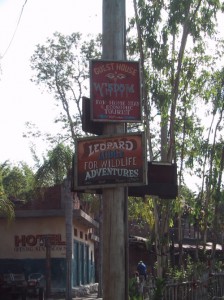One of the suggestions that we found most widely useful in Tim Ferriss’ “The Four Hour Workweek” was about how to use PO boxes. We all would prefer that our business address look like a “real place” instead of a PO box, but a PO box is all we can afford on our budget. Enter Tim Ferriss’ advised solution. If you have PO Box 203, look up your post office’s address and then send the mail to that address with #203 or “suite 203” appended so it looks like that’s your address.
Issues
We thought this was exactly the kind of handy tip that would make “The Four Hour Workweek” worth the money. We feared however that it wouldn’t be useful for us unless we were confident that the mail would actually get there. So to test it, we tried a variety of variations on the address to answer the following questions:
- Does it matter what addressee you put on the name line?
- Will it arrive if you use the post office’s address instead of your PO box address?
- Can you use strange variations of the box # to make your address look more legit?
Addressee

Things work a little differently in Tim Ferriss' world.
We would like to use our PO box for all of our businesses. We don’t really plan on getting that much mail, so the investment of a PO box for each business is going to eat into the small profits of each of these ventures. At the same time, we don’t know what all of those ventures will be right now, but we do know we need a PO box. So we basically just registered the PO box in the name “Protoscopic,” wanting to see if we could address mail to other businesses at the same address and have it arrive intact.
The post office seemed pretty explicit about needing all the names of recipients, so we were a little nervous; at the same time we were fairly confident that the postmen would rather just deliver it than return it over a name thing. So to test this, many of our variations included Walt Disney World For Grownups as the addressee instead of Protoscopic.
Post Office Address
Tim Ferriss’ method is predicated on the idea that your mail will arrive if you use the post office’s address instead of just the zip for your PO Box. This test was pivotal and much less of a foregone conclusion, so we used this in the majority of our variations. If this part didn’t work, the rest was irrelevant.
Box Number Variations
The first hiccup in this plan came when we were assigned our PO box number. It was six digits long, which doesn’t look like a realistic suite address at all. Our only solution to this was to try weird variations like “Suite 19-2548” or “Floor 19, Suite 2548”. We were far from confident this technique would work. The idea of putting “#192548” was not a complete deal-breaker though. It still looked slightly more “suite-like” than a PO box.
Results
Our results were disappointing to say the least:
- Mail addressed to the post office’s address with the PO box included arrived, but with the address struck through and “Bad Address” written on them.
- Mail addressed to the post office’s address with any type of “Suite” or “#” instead of the PO box did not arrive at all.
- At least the matter of the name seemed irrelevant. All our mail address to Walt Disney World For Grownups arrived as long as it used the correct PO box info.
Given this, it seems that it is quite unrealistic for us to use this method. While our sample space was fairly small (two different source locations and 5 letters each time), anything less than a 100% success rate is unacceptable. We were originally concerned that even if we met with success, we would have to keep testing to make sure everything was getting to us; but since the technique doesn’t seem to work for us at all, we don’t have to keep trying.
It may be that in smaller post offices or in other locales this technique will work, but for us it is not acceptable. Fortunately we don’t have a huge need for a realistic business address for any ventures in the near future. If however you were drop-shipping or engaged in some other type of very customer-centric business, this could be a considerable hold-up. A “Virtual Office” may provide a solution for this kind of problem, but is considerably more expensive. In the future we will look for cost effective alternatives, but for now we are just going with the PO Box.
Categories: Applied Use · Main blog narrative

We all get down about things sometimes.
While we are generally pessimists, there are three key areas that are marginally exceeding our expectations of difficulty:
- Link building
- Forums
- Organic Search
We attribute part of this difficulty to the “tightly-knit” profile of our target market. They are loyal to their current message boards and forums and are somewhat skeptical of new offerings. Thus the same things that make them desirable users also make them hard to woo. Additionally, the existing webmasters in the area are understandably reluctant to help promote our site. While we intentionally chose a niche market we felt would not be threatening, we are not surprised that we are not greeted with open arms.
Forum
Probably the most difficult aspect of getting WDWForGrownups going is the Forum. Everything I have read on the subject says patience is the key, however I get the feeling that the low level of response we’ve gotten so far is somewhat abnormal. Since this is also the most valuable aspect of the site, this is not that surprising. It is probably unrealistic to expect the forum to get rolling immediately; like any other site, good content is what will spur people to contribute their own.
One problem is that few of our “real life” friends are Disney World people. Annie has some online friends who are into Disney World, but they have not been overly responsive to registering and posting. We also don’t want to encourage our friends who are not particularly interested in the subject matter to post on the site, since that will lead to low quality content. Additionally, we really don’t want to make “fake users” and have “fake conversations,” because we feel it’s disingenuous. (It’s also a lot of work!)
I am not sure how important it is to keep the forum looking “up to date” to the day. We generally try to post when anything interesting comes up. Usually, we’ll post on a timely topic, leave it alone for a while with the hope that someone else will comment, and then comment ourselves when the topic is beginning to look stale.
If anyone out there has experience with forum building, we’d love to hear from you!
Link Building
Link building has also been a mild frustration. While my expectations were not overly high in this arena, the tight-knit profile of the market has been a hindrance here. We can all feel confident that unsolicited emails will have a low response rate; however, we have met with non-responses even to such simple acts as asking what it would cost us to sponsor events.
We have found some blogs that have a good synergy with our site, and when we post comments on their entries we usually see a fairly high (for us) influx of traffic for several days. We try to promote those blogs in return. However this kind of link-building is fairly short lived. It also isn’t clear how often these users are going to return.
The more “permanent” sorts of links have been harder to come by. Due to the unresponsiveness I mentioned, it’s been difficult to negotiate reciprocal links. Since we are a link directory, we are generally going to link to these people anyway so our value proposition is somewhat diminished as well. Our contact is usually something along the lines of “we are going to link to you, we’d appreciate you linking back to us,” which is obviously not as compelling as “we will link to you if you link to us.”
That being said, the frustrations in this area have not been as high as in other areas. We at least see some progress in this area, which gives us some encouragement. Also perfecting this skill will definitely pay off down the line.
Organic Search
Organic search is troubling at a more fundamental level. While we are not rated as well as we like yet for certain search terms, we are the number one result for ‘WDW for grownups’, which we expected to be at least a semi-frequent search. Despite this we rarely see any organic traffic.
Obviously this type of traffic is the most valuable, so our failure to lure any so far is troubling. In order to try to increase the number of search terms for which we rate highly, we have tried to increase the rate at which we write our articles. Hopefully the associations of terms in that area will help us rate higher for combinations that are unmet elsewhere.
Also, we are hoping that solving the other two issues will help improve our search ranking. If we have more links via link-building, we will have a higher PageRank, and if we are able to get our forums “rolling,” then we will have more content and a higher chance of searches landing there. Even the small bit of progress we have seen in the forum has led to a few organic landings, such as when a search for ‘xxxx’ resulted in a landing in our forum. While this search may not be common, as our content increases these could become a significant source of traffic.
Continuing Strategy
We currently have not made any major “pushes” to promote our site. We have yet to pay for advertising or attempt to optimize our site further for search terms. We see no reason to panic about our current troubles as we are early in the process and feel like there will be good synergy in solving them. All that being said we will be closely monitoring our progress in these areas.
Categories: Main blog narrative
Adding “Get Started Here” Section With Buttons
We have substantial content and pictures in place. We have decided to add a WDW Experts section to the site and have created an Expert Quiz to make the site more interactive. Now we want to get those things that we think will drive traffic to the site (Experts section and planning section), generate referrals (Quiz), and bring in repeat visitors (discussion forums) front and center.
 Clearly we want links on the home page for these site sections, but text links just aren’t strong enough (besides they’re buried in the home page text and nobody reads home page text, do they?). Brad was playing around with button-makers online, so we decided that flashy buttons on our home page are just the thing we need to generate interest and color on the page.
Clearly we want links on the home page for these site sections, but text links just aren’t strong enough (besides they’re buried in the home page text and nobody reads home page text, do they?). Brad was playing around with button-makers online, so we decided that flashy buttons on our home page are just the thing we need to generate interest and color on the page.
We started with a bright yellow button (“Start Here!”) that directed visitors who were new to WDW and hoping for planning advice to our article about “planning basics.” After a couple of days, we’ve decided to create a “Ways to get started with this site” section on the home page, where we’ve placed buttons (of a more site-friendly color) directed at four sections of the site (stated above: trip planning basics article, forums, expert section, and quiz).
Adding a Tip of the Day
Upon the suggestion of a family member, we decided to also add a “Tip of the Day” to the home page. This does three things: 1. shows visitors that the site is being updated regularly, 2. allows us to show our credibility by showcasing knowledge of little-known WDW tips, and 3. allows us to build even more links to our forums and/or site content on our home page, bringing visitors deeper into the site when they click on links in the Tip of the Day.
So far, the Tip of the Day has been a useful addition to the site, though we’re not yet sure if it’s improving our traffic or retention levels.
Questions Remaining:
- Does our list of “get started” buttons compete too much with our lefthand menu? Is the home page too busy for new visitors?
- Are the sections of the site to which we’ve pointed buttons really our most reliable for generating traffic?
- Do we have two target markets: experts and new-to-WDW planners? Should we narrow it and reconfigure the site for one or the other?
Categories: Applied Use · Main blog narrative




